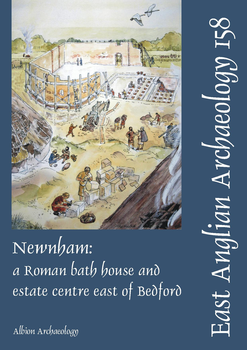Newnham, Bedford: A Romano-British Bath House and Estate Centre
Albion Archaeology, 2018. https://doi.org/10.5284/1042740. How to cite using this DOI
Data copyright © Albion Archaeology unless otherwise stated
This work is licensed under the ADS Terms of Use and Access.
Primary contact
Helen
Parslow
Archives Officer
Albion Archaeology
St Mary's Church
St Mary's Street
Bedford
MK42 0AS
UK
Resource identifiers
- ADS Collection: 2745
- ALSF Project Number: 5728
- DOI:https://doi.org/10.5284/1042740
- How to cite using this DOI
Introduction

The Roman settlement site at Newnham was excavated in advance of gravel quarrying between 1972 and 1975, under the direction of Angela Simco. Unexpectedly found to contain the remains of substantial Roman buildings, including a range with a hypocaust heating system, the site was interpreted as one of a very small number of supposed Roman villas known from Bedfordshire. It also produced intriguing evidence of Saxon occupation. The site has now been totally quarried away, but the results of the excavation were never fully analysed or published and the site archive was accessioned to Bedford Museum in 2000.
Analysis and publication has been made possible with a grant from the Aggregates Levy Sustainability Fund (ALSF), via Historic England and DEFRA, to make the results of investigation of this regionally important site available to archaeologists and the public. The publication restores a degree of significance to an important archaeological site that, for many years, has only ‘existed’ as a blob on the Bedford HER and an un-synthesised excavation archive deposited in the museum vaults.
The analysis has demonstrated with reasonable certainty that the settlement at Newnham was not a ‘villa’ in any meaningful sense. Although in later phases it possessed some important elements of a higher status site – particularly in comparison with contemporary sites in the area – it lacked the full set of attributes. It is better interpreted as a high-status farmstead, possibly a focal point within a large estate.
The site began its life as a settlement based on agriculture and this remained the core activity throughout the phases. Other than a few fragments of early Iron Age pottery, no evidence of early prehistoric activity was recognised, with settlement on the site beginning in earnest in the late Iron Age/early Roman transitional period. A review of crop-mark evidence has concluded that a group of linear boundaries and an enclosure to the west of the excavation trenches may have been prehistoric, but none of the crop-marks is conclusively indicative of pre-Roman activity.
A relatively large timber building was constructed in the 1st century AD, which was either joined or replaced shortly afterwards by another timber building that had stone foundation and indications of high status, if not necessarily great affluence. Small-scale industry was carried out within an agricultural setting, with evidence of metalworking and pottery manufacture in the vicinity. The settlement was at its peak in the mid-Roman period when a bath-house was built, and it has been suggested that this part of the site became less involved with the basic functions of agriculture or domestic activity.
Decline came at the end of the Roman period, with the bath house apparently the focus of large-scale butchery. There is no structural evidence to suggest that settlement carried on into the Saxon period, but the presence of a moderate quantity of Saxon pottery indicates that the settlement was not simply abandoned at the end of the Roman period. The pottery seems to indicate that by the time occupation on the castle site at Bedford was being established in the early Middle Saxon period, occupation at Newnham had ceased.







